
|
GREATEST FILM SCENES 1950s (2) |
|
# 64. The Seven Year Itch (1955) The luscious, sexy screen goddess Marilyn Monroe will always be remembered for her immortal image filmed in Billy Wilder's comedy. As The Girl (Marilyn Monroe), a stunning, curvaceous, sexy, wide-eyed blonde wearing a tight white dress, she is the new upstairs tenant for the summer in a building occupied by Richard Sherman (Tom Ewell), an imaginative book publisher who has remained in Manhattan rather than join his wife and son on vacation. He has been married for seven years and is entering the phase when married men's eyes and attentions are tempted to wander for extramarital adventures, but he has always been faithful. However, his new neighbor's arrival puts his virtuous resolutions to the ultimate test. He invites the Girl to dinner and then to an air-conditioned movie on a hot summer evening. In the film's most remembered scene, the famous "skirt scene," they leave a movie theater screening. They discuss the movie they have just seen: The Creature From The Black Lagoon. She feels sympathy for the creature: "Didn't you just love the picture? I did. But I just felt so sorry for the creature at the end...He was kinda scary-looking, but he wasn't really all bad. I think he just craved a little affection - you know, a sense of being loved and needed and wanted." In an immortal image, finding it unbearably hot, she cools off by standing astride a vent-grating over the subways. She smiles as moving trains below blow and lift her dress upwards above her legs with a rush of air: "Oh, do you feel the breeze from the subway. Isn't it delicious?" She attempts, unsuccessfully, to keep her dress down. Sherman stands to her side, gaping at her, commenting: "Sort of cools the ankles, doesn't it?" Soon, another train comes by, and she squeals with child-like delight as it blows her skirt up one more time ("Oh, here comes another one!"). |
   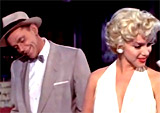 
|
|
# 65. The Searchers (1956) Both the beginning and ending of John Ford's classic western symmetrically involve a framed door. The film begins with a frontier cabin door opening onto the horizon of the Monument Valley wilderness, the passageway between two worlds. The interior area in the cabin represents civilized values and the settled family. The bright, glaring, sunny outdoor area represents the savage and threatening land of the frontier loner. The black silhouette of a frontier woman Martha Edwards (Dorothy Jordan) moves from the darkness through the door to the brightly sunlit wilderness outside. Moving excitedly to the porch, she notices a man approaching - in the center of the frame - who slowly rides in from the desert in a mythic entrance - the man is framed between two distant buttes. After several years of mysterious absence following the Civil War, loner Ethan Edwards (John Wayne), her brother-in-law, suddenly appears with no explanation, returning on horseback to his brother Aaron Edwards' (Walter Coy) family, living on a solitary, Texas frontier farm. In the film's finale, after Ethan's obsessive, long, vengeful campaign to safely retrieve his kidnapped niece Debbie Edwards (Natalie Wood) from Comanche Indians (although initially he wants to kill her due to being 'ruined' by becoming one of the squaws of Chief Scar (Henry Brandon)), he remains a tragic figure - a loner and outsider, after bringing Debbie back to the Jorgensen homestead. He stands for a few moments, lingering outside as the camera pulls back into the darkened inside of the home, the doorway framing the scene. Ethan steps up onto the porch, then hesitates and steps to one side as others behind him enter, reunited once and for all - unlike Ethan who is fated to wander and cannot live in a civilized, family-based community. He grasps his right elbow with his left hand (a fond remembrance of the stance of silent western star Harry Carey, Sr.), and then decides to remain behind, looking after them. He turns away, his silhouette framed in the open doorway, walking into the swirling dust. The eternal loner, he wanders alone (like the fate of the dead Indian whose eyes he shot out) back into the alien, desert wilderness, similar to how he entered the picture so many years before, but now reversed. The door to civilization and the family hearthside swings shut on him, making the screen black. |
    |
|
# 66. The Ten Commandments (1956) The last film of legendary director/producer Cecil B. DeMille was a remake of his earlier film from 1923, the melodramatic Biblical epic - a spectacular, at times vulgar, wide-screen special effects extravaganza. The familiar tale of the Hebrews' Exodus is not remembered for its script or most of its static acting, but for its excessive, gigantic scale. Following a series of vivid, beautifully-staged plagues that Moses (Charlton Heston) unleashes upon the bare-chested Pharaoh Rameses (Yul Brynner) and the royal house (one in which water turns to blood), the children of Israel are permitted to leave Egypt in an elaborately-filmed Exodus. Blasts from horns provide a signal as thousands of former slaves are released from bondage and set on their way toward the Promised Land.
As the gray-bearded Moses views the mass of Hebrews preparing to leave Egypt, he exclaims during this enormous crowd scene: "There are so many, so many." Aerial shots capture the liberating moment as their maroon-robed leader takes them into the wilderness ("And he brought forth the people with joy and gladness. He bore them out of Egypt as an eagle bears its young upon its wings"). The much-anticipated scene of the parting of the Red Sea never fails to entertain audiences - it is one of the most miraculous special effects scenes in film history, prefaced by Moses' statement as he summons a pillar of fire to delay the pursuing chariots: "Fear not. Stand still and see the salvation of the Lord." At the water's edge on a rock promontory, he holds his staff up to the sky, as black clouds roll in behind him. To part the swirling, wild waters of the Red Sea swirl, he commands with outstretched arms: "The Lord of Hosts will do battle for us. Behold his mighty hand." A blind old man comments: "God opens the sea with a blast of His nostrils!" After the Hebrew people are led through the midst of the walls of water, the Egyptians take chase after them. The waters crush down and cover the chariots when Moses commands on the other side: "Who shall withstand the power of God?" |
  
|
|
# 67. The Bridge on the River Kwai (1957) David Lean's war epic features the psychological, confrontational struggle of wills between a determined British Army Colonel Nicholson (Alec Guinness) and the commander of a Burmese POW camp in SE Asia Colonel Saito (Sessue Hayakawa). The two protagonists are symbols of different, opposing cultures, but actually they share much in common - pride, dedication, and stubborn obedience to their codes and rules. Although the exciting finale of the film is spectacular - including the attack of the commandos, the destruction of the railroad bridge by Nicholson's own death as he falls on the dynamite plunger as he exclaims: "What have I done?", and the image of the trainload of Japanese dignitaries plunging into the Kwai river, there is another more compelling scene. Stoically and stubbornly, Nicholson keeps his men standing in the hot sun all day long after their arrival in the POW camp, rather than letting his officers work side-by-side in physical labor with the enlisted men. After being beaten, Nicholson is dragged to a corrugated, metal-encased, "oven" sweat box to be tortured in the blazing sun so that he will change his mind. The power struggle continues for many days as both commanders rigidly refuse to give in - until Saito finally breaks. In a triumphant scene, an exhausted, near-collapse, but composed Nicholson is released and walks bulldoggedly under his own strength and power to Saito's quarters. He determinedly staggers across the compound yard and up the steps. In honor of the anniversary of the Japanese defeat of the Russians in 1905, Saito gives the troops a day of rest, declares a "general amnesty," and accepts Nicholson's terms: "You and your officers may return to your quarters. As part of this amnesty, it will not be necessary for officers to do manual labor." Nicholson smiles proudly, buttons his disheveled uniform and then strides onto the porch to leave Saito's quarters. His men watch expectantly and then when their commander emerges free, someone jubilantly exclaims: "He's done it!" and the men cheer for his triumph and surround their commander from all sides. The victorious commander weaves into the rush of ecstatic soldiers. The other officers are released from their punishment hut and personally greeted. Inside Saito's quarters, the Japanese commander has saved face, but he cries on his bed - his honor has been shamed. |
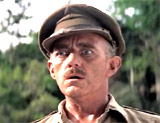    
|
|
# 68. The Defiant Ones (1958) The single-most symbolic image of the encouraging state of the development of race relations in the US was in Stanley Kramer's social commentary film. Two convicts - white John Jackson (Tony Curtis) and black Noah Cullen (Sidney Poitier), are shackled together. When they escape from a southern chain gang, they must cooperate with each other and put aside their racial animosities as they evade the oppressive search of the police. Held together by a 29 inch steel chain, they are manacled to each other, and only bound by their will and determination to escape. In the film's final sequence, the two men hear an approaching freight train. They frantically pursue it and Cullen is able to get onto one of the moving cars. He reaches back with one free hand and pleads for his white companion to "run" faster. They lock hands with his each other (a memorable image of black and white hands and arms locked together) but he cannot pull Jackson up onto the moving train. So he sacrifices his own freedom and falls back off the train onto the ground. In their final few moments of freedom, they share a cigarette, and Cullen sings the blues classic "Long Gone" as the sounds of bloodhounds on their trail closing in on them are heard in the distance. |
  
|
|
# 69. Touch of Evil (1958) Probably the most dazzling opening sequence in any film is the one in the greatest B movie ever made - Orson Welles' late film noir. The film opens with an audacious, incredible, breathtaking, three-minute, uninterrupted crane tracking shot under the credits (appearing superimposed on the left of the screen). In a close-up, hands set an explosive, timed device. A shadowy figure runs and places it in the trunk of a parked convertible. The pounding of bongo drums and blare of brass instruments are heard (Henry Mancini's score), accompanied by the ticking of the mechanism on the soundtrack. The camera pulls away sharply, identifying the car's location - it is parked on a street in a seedy Mexican border town. An unsuspecting, wealthy American man - Rudi Linnekar (the boss of the town) and his giggling, blonde floozy, mistress/girlfriend (a striptease dancer named Zita) emerge out of the background darkness and get into the car, driving off through the streets toward the US-Mexican border. From high above, the camera tracks the movement of the doomed pair in the shiny car through the squalid-looking town. It is a dark night as they drive through the town, the setting for the rest of the film. In the border town, there are flashing neon and electric signs, tawdry hotels and stripjoint nightclubs ("The Paradise"), crumbling arches, dark roofs, winding streets and twisting alleys with peeling posters on sides of walls and houses, heaps of trash, and vendors pushing carts. The black-and-white visuals emphasize the seedy atmosphere and the moral decadence, decay, and nightmarish dirtiness of the scene. As the convertible moves along and then turns a corner and stops at a traffic light, the camera descends and picks up another cheerful couple, Ramon Miguel "Mike" Vargas (Charlton Heston), a handsome, Mexico City narcotics investigator with his voluptuous blonde, honeymooning American bride Susan Vargas (Janet Leigh). They are walking down the street, moving across the road where the car has stopped at the traffic light. (The rigged car and the Vargas couple are both on their way through the town to the US/Mexican border.) Each group arrives at the border checkpoint at the same time. The walking couple must answer a few formal questions. The blonde floozy complains to the border guards about the ticking noise she hears in the back of the car, but she is ignored by the border official and her companion. The car moves past the checkpoint across the border after clearance, driving out of the frame. Just as the newlyweds kiss, the sound of the explosion of the detonated car overlaps on the soundtrack, and they turn their faces toward the blast. The film makes its first cut (after almost three minutes) to a view of the flaming body of the car in midair. |
 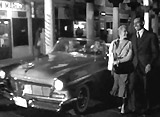    
|
|
# 70. Vertigo (1958) Hitchcock's psychological, dramatic masterpiece of sexual obsession, follows a vertigo-inflicted ex-San Francisco policeman John "Scottie" Ferguson (James Stewart) who takes a job from former classmate Gavin Elster (Tom Helmore) to shadow his wife Madeleine Elster (Kim Novak). Just when he is falling in love with her, she falls to her death and he slips into a deep depression. And then he meets another woman Judy Barton (also Kim Novak) who looks just like Madeleine. Falling in love with her, he suggests clothes - the gray suit - like Madeleine wore, obsessively trying to mold, remake and groom Judy into the dead woman's image. His desire to design and make her into his idealized image of Madeleine becomes a fetish. In Scottie's apartment, Judy appears frightened that Scottie loves his lost-love Madeleine more than herself, the real-life Judy. She pleads with him to love her for who she is and to stop psychologically stripping her of her own identity. Judy insists on not being a reminder of his lost love, also fearing that she will become the Madeleine of the deadly plot and may be recognized. Pathetically, she finally gives in, allowing him to exploit her and change her appearance, fulfilling his dream. In the film's most memorable sequence, when Judy has finally made the full transformation into Scottie's image of Madeleine, the camera focuses on Scottie pacing around before she emerges from the bathroom. Slowly, the door opens and we see Scottie's hopeful eyes filled with wonder and emotion in an unforgettable image, as he (and the viewer) sees the reborn reincarnation of his lost love. Anxious to please him because of her love for him, Judy slowly walks toward him, remade to look exactly like "Madeleine" - a fabricated image of a woman created by Elster to masquerade a murder plot. We see from Scottie's point of view - the ghostly figure appears in the eerie green-tinged neon light reflected from the hotel sign outside the window. Her metaphysical, spiritual figure assumes solid shape as she moves out of the ghostly green light and crosses the floor to him, to embrace and kiss passionately. The camera pans and swirls around them (their background surroundings dissolve and place them in the livery stable in Scottie's subjective imagination, the location where he had attempted to cure Madeleine's hallucinations) - the sensation must be the same distorted but gratified feelings Scottie is experiencing - vertigo. Completely lost in the dream, overlapping fantasy and reality, the loving couple continue kissing in front of the pale, greenish haze of the window. |
 
|
|
# 71. Ben-Hur (1959) The spectacular, memorable eleven-minute chariot race in this epic was filmed on a gigantic racing set - the largest single film set in cinematic history. The setting for the exciting action scene is majestically impressive with a central divider strip composed of three statues thirty feet high, and grandstands on all sides, rising five stories high and filled with thousands of extras. Before the race, the charioteers parade around the ring in a display of pageantry - the focus is on the two chariots of Ben Hur (Charlton Heston) and arch-enemy Messala (Stephen Boyd) - with white and black horses respectively. A crown of victory will be given to the victor - the chariot that first completes nine rounds. The eager horses and chariots are held back at the starting point until the signal to begin the race is given. The battle between the competitors is highlighted by a series of close ups of the action, as the chariots race around the great stone idols in the center of the arena. One by one, Messala eliminates the other drivers in the ferocious race, shattering their chariots. The climactic ending to the race occurs when the chariots of the two dueling rivals run neck-and-neck and slash at each other. Messala tries to destroy Ben-Hur's chariot by moving close with its rotating blades, but as the wheels lock and he loses one of his wheels, Messala's chariot is splintered into pieces. He is dragged by his own team, then trampled, and run over by other teams of horses. Defeated, he lies in the dirt, his body a broken bloody pulp. [The chariot race in the 1925 silent film of the same name between Ramon Novarro (Ben-Hur) and Francis X. Bushman (Messala) is equally spectacular.] |
      
|
|
# 72. North by Northwest (1959) In the most-renowned and brilliant sequence of director Alfred Hitchcock's career, handsome business executive Roger Thornhill (Cary Grant) is lured into the flat countryside by enemy spies on the pretext of meeting the fabled Kaplan. He arrives at a barren road-crossing out in open farm country surrounded by plowed-up dirt and cornfields, incongruously dressed in a neat business suit in bright sunlight. He is entirely exposed and vulnerable - a modern, urban individual without any amenities or artificial resources. There is a graphic contrast between his vertical figure and the flat horizon. Surrealistically, suspense slowly builds as cars pass through the desolate area. A truck sprays him with road dust. A car drops a man on the other side of the road from him to wait for a bus - is this man Kaplan? A crop-dusting plane is engaged in dusting a nearby field. The man remarks that it is odd to have a small plane crop-dusting a crop on a field devoid of crops: "That's funny...That plane's dustin' crops where there ain't no crops." After the man boards a bus, the distant, innocent and harmless crop-spraying plane immediately and without warning terrorizes him, swooping down like a bird of prey out of a clear blue sky, flying almost at ground level and spraying machine-gun fire. Thornhill ducks for cover from the strafing attack, but there is nowhere to hide and no way to defend himself in the vast expanse of the setting - the third vicious attack on his life. The plane circles and returns a few times as he fails to flag down and stop a car. Thornhill runs for cover in an open cornfield, but the bi-plane showers him with a load of poisonous pesticide to flush him out. He returns to the road and runs in front of an approaching semi-trailer Magnum Oil truck, forcing it to stop. He falls under the truck's front bumper as the plane uncontrollably crashes and explodes into the truck's gas tank. |
 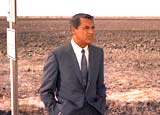  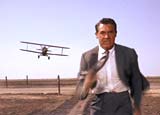 
|
|
# 73. Some Like It Hot (1959) Billy Wilder's outrageous, comedy farce favorite is one of the most hilarious films ever made. It is a clever combination of many elements: a spoof of 1920's gangster films with period costumes and speakeasies, a comedy with one central joke - entangled identities and cross-dressing, and non-stop action, slapstick, and one-liners. To escape from vicious gangsters in Chicago, Joe/Josephine (Tony Curtis) and Jerry/Daphne (Jack Lemmon) disguise themselves as members of an all-girl orchestra. While Joe sneaks out looking like a millionaire and sounding like Cary Grant to woo Sugar Kane (Marilyn Monroe), one of the band members, Jerry is wooed by yacht owner Osgood Fielding III (Joe E. Brown). In the film's classic closing scene in a pre-arranged getaway boat, Jerry attempts to end his relationship with Osgood, breaking the news gently to him by discouraging his affection - but he isn't successful:
|
  
|
1950s (1) | 1950s (2) | 1960s | 1970-90s |
|